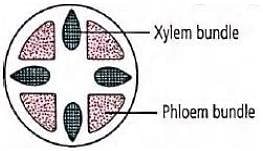Test: The Tissue System (NCERT) - NEET MCQ
10 Questions MCQ Test Biology Class 11 - Test: The Tissue System (NCERT)
Given figures (P and Q) represent the stomatal apparatus of dicot and monocot leaves respectively. Select the option which correctly labels A, B and C.




| 1 Crore+ students have signed up on EduRev. Have you? Download the App |
Which of the following tissue systems constitutes bulk of the plant body?
Lateral meristems are cylindrical meristems and they occur in the mature regions of root and shoot of many plants. Which of the following are examples of lateral meristems?
a. Cork-cambium
b. Intercalary meristem
c. Fascicular vascular cambium
d. Apical meristem
Identify the type of vascular bundle as shown in the figure and select the incorrect statement regarding this.

Why are monocotyledonous vascular bundles referred to as closed?
What do open vascular bundles possess that allows them to form secondary xylem and phloem tissues?
What distinguishes open vascular bundles from closed vascular bundles?
Which of the following structures is responsible for gas exchange in plants?
|
182 videos|367 docs|152 tests
|













